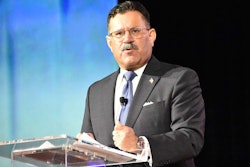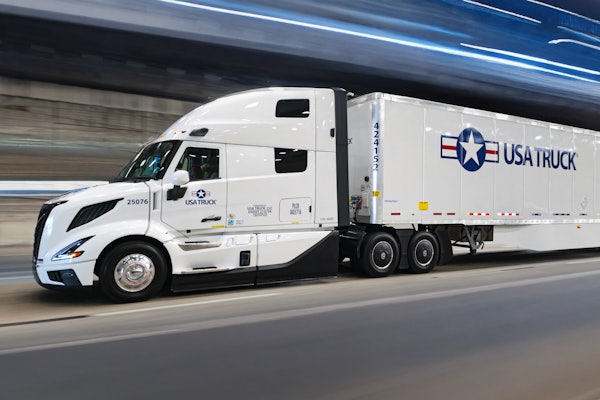 “I am learning that miles are increasingly mattering less and less. I am almost of the opinion that they don’t matter at all. What matters is time,” said Ray Greer, chief executive of Omnitracs.
“I am learning that miles are increasingly mattering less and less. I am almost of the opinion that they don’t matter at all. What matters is time,” said Ray Greer, chief executive of Omnitracs.Fleet attendees at the Omnitracs Outlook user conference on Tuesday, Feb. 26, were given a vision of time replacing miles as the bedrock metric in trucking.
By many accounts it already has. Most measurements used by fleets and drivers such as hours-of-service, speed (mph), appointments and even payroll are based on time. One of the few holdouts is freight rates.
What if shippers and carriers replaced mileage with time to calculate and negotiate rates? Omnitracs, a mobile fleet management technology provider, wants to accelerate on the path towards this future state.
Getting ready
Soon after Ray Greer became chief executive of Omnitracs in February 2018, the company hired the Boston Consulting Group to help develop a strategic plan. This led to hiring a third-party software developer, Redhat, to “change the way we develop and deploy solutions,” he said.
The process also led to a complete organizational redesign. “It’s one thing to have a strategy and vision and another for an organization to have the ability to execute on that strategy,” he said.
About four months ago, Omnitracs hired Michal Yariv as vice president and general manager of strategic initiatives.
“We really needed to find a leader that comes out of the industry,” said Greer. With a background in technology and logistics, Yariv shared the vision of Omnitracs to move the industry towards a time-based system for freight to improve efficiency and safety.
“What if we could make it all align?” she asked. “What if we could align payment against the hours that are actually being spent to move that shipment?”
The cost of detention
 Michal Yariv, Omnitracs vice president and general manager of strategic initiatives.
Michal Yariv, Omnitracs vice president and general manager of strategic initiatives.Alignment is already happening with driver wages. Fleets in the for-hire truckload market are taking actions to pay their drivers on an hourly or salary basis. A recent survey by Omnitracs found that approximately 33 percent of its customers are thinking about an hourly or salaried model for drivers. Of those, 30 percent are already in the process of implementing such pay models.
About 66 percent of fleets are not considering an hourly or salaried model. Of these, about 40 percent say the reason is because shippers pay by the mile, she said.
The trucking industry is in a post-ELD world where minimizing wasted time and making the most of the time drivers have is essential.
People think of time and make decisions based on time depending on the context. Using a football analogy, she explained that time does not matter so much in the first quarter of a game but a sense of urgency kicks in during the fourth quarter with the game on the line. Teams practice two-minute drills and begin calling plays to manage the clock, such as passing to the sidelines.
“In this post-ELD mandate world, we are in the two-minute drill,” she said.
Detention is one of the top concerns for fleets and Yariv cited a study that pegs the cost to the trucking industry at one billion dollars a year.
“That is a billion that is lost in driver wages. It’s the driver who is being impacted by detention and what they take home in their paycheck,” she said.
Detention is a safety issue as well. Last year, the FMCSA issued a report that said a 15-minute increase in the average dwell time of a load can increase the average expected crash rate by 6.2 percent. Because pay is based on miles, drivers speed up to make up for lost time spent waiting, which also makes drivers become fatigued and frustrated, she said.
Evaluating loads
 Omnitracs is developing the Omnitracs One platform that will use the same software platform across multiple devices.
Omnitracs is developing the Omnitracs One platform that will use the same software platform across multiple devices.Carriers already evaluate and price loads based on revenue per hour, but what if they had more data intelligence about expected wait times and transit times?
Mike Gabbei, chief information officer of Celadon, says the Indianapolis-based truckload carrier knows the dwell times and transit times for about 70 percent of the loads in its business.
Other carriers lack any data at all and rely on tribal knowledge within their organizations. Yariv cited a survey of Omnitracs customers that shows 75 percent of carriers do not have information in their systems about detention times.
“Your data is only as good as size of your fleet,” she said.
Large and sophisticated carriers such as Celadon have detention data for shipments, customers and routes they have already serviced but lack data for the freight they have not. What if a company wanted to expand its business or go to the spot market to find loads?
Omnitracs tracks locations daily for 1.2 million trucks operated by 12,000 customers. Location tracking amounts to about 30 terabytes data annually. Yariv and Greer discussed the company’s plans to model this data to determine where trucks are being held up, and to safely and efficiently route drivers and help fleets make better decisions.
The goal, said Yariv, is to create models that predict with accuracy of 95 to 98 percent how many hours it will take to service any and all loads from pickup to delivery, taking into account travel times and delays from various factors.
“We want to take into account things like seasonality and time of day to determine the likelihood of being detained,” she said.
Celadon’s Mike Gabbei believes that drivers will be the biggest benefactor of mileages being replaced with time-based metrics.
“We’ve got to do something from the driver side to bring drivers into the market. Drivers want stable pay,” he said.












